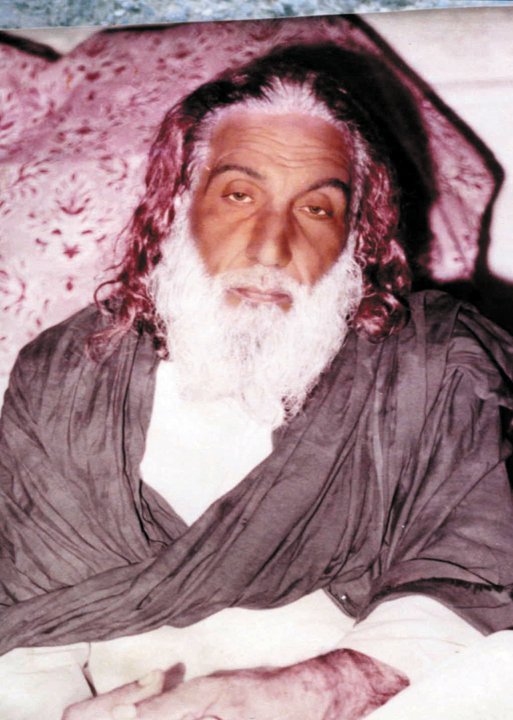Grandfather

Khawaja Syed Suleman Gilani (RA) was born on August 1, 1919, in Quetta. His ancestors had migrated from Baghdad Sharif, first settling in Afghanistan, and later in Quetta (Balochistan) as well as in the areas of the North-West Frontier Province (now Khyber Pakhtunkhwa) including Risalpur, Chamkani, and Adamzai (Nowshera).
Syed Suleman Gilani’s lineage, through seventeen generations, traces directly to Piran-e-Pir, the Enlightened Saint, Ghaus-ul-Azam, Dastgeer, Sayyiduna Hazrat Abdul Qadir Jilani (RA).
During a gathering in Attock, along with his friend and teacher Ghulam Sarwar, he first saw Baba Ji Hazoor (RA), and instantly gave his heart and soul to him. When he presented himself for bay‘ah (spiritual allegiance), Baba Ji Hazoor refused, saying:
“You are a Sayyid, and I am a Khattar, so I will not take your bay‘ah.”
Determined, Khawaja Syed Suleman Gilani performed a 21-day spiritual retreat (chilla) at the blessed shrine of Hazrat Musa Renyal (RA), completely abstaining from food and drink. On the 21st day, by the grace of Allah Almighty, the saint of the shrine appeared to him in a spiritual unveiling (kashf), and in that state, Hazrat Musa Renyal (RA) accepted him into his exalted spiritual order and said:
“Go now, Bahram Renyal (RA) will take your bay‘ah.”
And so it happened. After the bay‘ah, his noble spiritual guide sent him—according to his wish for spiritual struggle and discipline—to a mountain in the famous Gandgar Range near Subra, in the Hazara district, for another retreat.
There, Khawaja Syed Suleman Gilani engaged in ten months of intense spiritual discipline, surviving daily only on tea and a single potato roasted over coals. After this rigorous period, Baba Ji Hazoor himself came to Subra, brought him down from the mountain, and in Daman Koh held a spiritual musical gathering (sama‘). There, the Shaykh formally announced his khilafat (spiritual succession), presented him with the cloak of succession (khirqah), a black shawl, and a patched robe (muraqqa‘).
Baba Ji then brought him to Attock, where they stayed for two days. After granting him ijazah (authorization) and khilafat, Baba Ji first entrusted to him some people from his own village, Narrah Sharif, for spiritual guidance, and then ordered him to engage in religious propagation near Subra. Following the Shaykh’s instruction, the place was named Darvesh Abad, where he stayed for about eight years.
When the Tarbela Dam scheme began, the government evacuated the area and relocated the residents. Khawaja Syed Suleman Gilani moved with his disciples to District Lodhran (then a tehsil of District Multan), settling near Qasba Jalla Arain in a small settlement close to Chak Mujahid, which he also named Darvesh Abad. There, he lived for about 10–12 years, preaching and guiding people. In addition to Friday and Eid congregations, he arranged religious education for students, and soon Darvesh Abad became a religious center for the surrounding villages. Students from nearby areas began to come to its mosque for Islamic studies.
In his later years, he moved to Faisalabad, established his seat of spiritual guidance, and continued his mission of preaching and directing seekers. It was here, on April 26, 1986 (15th Sha‘ban 1406 AH), that he passed away and, according to his wish, was buried in Narrah Sharif.
Khawaja Syed Suleman Gilani was a highly learned and devout man, fluent in Urdu, English, Persian, Arabic, Pashto, and Punjabi. He was a hafiz of the Qur’an, though he had not memorized it in the traditional way. He would say that through a single spiritual glance of his Shaykh, he memorized the entire Qur’an.
In his gatherings, alongside the general public, scholars would also be present to benefit from him. Many of his disciples were huffaz (Qur’an memorizers), scholars, and prominent preachers. His followers were found in large numbers in Faisalabad, Multan, Sargodha, Karachi, Lodhran, Bahawalpur, Lahore, Lala Musa, Sialkot, and other major districts of Punjab, as well as in the NWFP districts of Peshawar, Bannu, Nowshera, Haripur, Hazara, etc.
He lived his entire life in poverty and simplicity, always sitting on a straw mat, whether at home or during travel, amidst his friends and devotees without distinction, in a warm and friendly atmosphere. His gatherings were filled with constant preaching and advice. Few words, little sleep, and minimal food were his lifelong habits.
Qadri Order
Rehan Gelani’s family traces its lineage to the Prophet Muhammad’s (peace be upon him) beloved daughter, Lady Fatimah Zahra A.S. Through Imam Hasan A.S and Sheikh Abdul Qadir Gelani, the family is referred to as Hasani and Gelani. They are also called “Gelani Azizi” because of their connection to Sheikh Abdul Qadir Gelani’s son, Abdul Aziz Al-Gelani.
The family’s ancestors include Syed Abdul Wahid Gelani, who was the first to migrate from Iraq to Afghanistan and later to Pakistan. His descendants settled in Balochistan and Peshawar, and now various branches of the family live in Peshawar, Attock, Lahore, Quetta, and Rawalpindi.
Rehan Gilani S/O Syed Muhammad Abrar Hussain Shakirulqadri S/O Syed Muhammad Suleman Alqadri S/O Syed Muhammad Rahim S/O Syed Muhammad Faqir Hussain S/O Syed Fazl-ud-Din S/O Syed Shah Muhammad S/O Syed Muhammad S/O Syed Abdul Wahid S/O Syed Muhammad Dervish S/O Syed Husamuddin S/O Syed Nooruddin S/O Syed Waliuddin S/O Syed Zainuddin S/O Syed Sharafuddin S/O Syed Shamsuddin S/O Syed Sirajuddin Muhammad Al-Hattak S/O Syed Muhammad Shamsuddin S/O Abu Bakr Abdul Aziz S/O Syed Abdul Qadir Gelani.
Rehan Gelani’s Spiritual Order
In the Qadri spiritual order, Rehan Gilani’s spiritual lineage is the same as his family lineage. His grandfather, Khawaja Syed Muhammad Suleman Al-Qadri Chishti, underwent a year of rigorous spiritual practice on a mountain in District Ghazi. Afterward, he was granted spiritual authority (Khilafah) in the Chishti, Naqshbandi, and Suhrawardi orders by Khawaja Bahram Ranyal (may Allah have mercy on him). He dedicated his life to preaching, guiding, and spiritual reform. During his lifetime, he appointed his son, Syed Shakir Al-Qadri Chishti Nizami (Rehan’s father), as his disciple, successor, and spiritual heir.
However, Syed Shakir Al-Qadri Chishti Nizami focused on scholarly and research work instead of traditional spiritual leadership for a long time. In the Chishti order, being a learned scholar is considered essential for spiritual leadership. He sent Rehan Gelani for religious education right after matriculation in, deciding that Rehan would take on the responsibilities of spiritual leadership after completing his studies. Rehan began his academic journey in 2003 at DMG Bhera in Sargodha, which continued until his Ph.D.
After completing his education and Ph.D., and following his marriage, Rehan’s father, in 2021, formally bestowed upon him the mantle of spiritual leadership (dastar-e-khilafah) in accordance with the traditions of their spiritual order. This ceremony was conducted by Khawaja Bahram Rinyal Narvi’s successor, Sahibzada Jameeluddin Ahmad Chishti. In the same event, Sahibzada Hassan Nawaz Shah granted Rehan the spiritual authority in the Suhrawardi and Kubrawi orders. Additionally, Rehan received the Qadri Qalandari khilafah from the shrine of Syed Shah Muhammad Kazim Qalandar in India.
Rehan Gilani’s spiritual mentor (Sheikh-e-Tariqat) is his father, Syed Shakir Al-Qadri Chishti Nizami. With his father’s permission, Rehan has also benefited from the knowledge and company of many other spiritual masters, whose names are too numerous to list here. He is authorized to accept disciples (murids) in all major spiritual orders.
